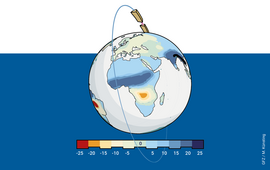
The many geodetic and geophysical measurements from satellites, airplanes, and terrestrial networks contain comprehensive information about Earth system dynamics. They are, however, only a snapshot of the dynamic status of our planet. Since these measurements reflect the effects of many different, concurrently active processes, they cannot be interpreted without additional contributions from theory and models. This is the focus of the work in Section 1.3. We concentrate on the modelling of transfer of mass, momentum and energy in the Earth system. This includes the simulation of the static and time-varying portions of the Earth's gravitational and magnetic fields, the deformation of the Earth's surface, changes in sea level and variations in Earth's rotation.
The geodetic parameters and fields, like the Earth's shape, its gravitational field and its orientation in space, are affected by many dynamic processes. The causes for their variation stem from all different parts of the Earth system, from the upper atmosphere to the core. By means of numerical simulations we trace these influences and draw conclusions about the dynamic processes from measured changes. For example, we model how the changes in global atmospheric wind systems, ocean currents and continental water systems affect the Earth's rotation. We investigate the viscoelastic response of the Earth's crust to changes in continental ice masses and determine resulting changes in sea level. In contrast to short term elastic deformations, this isostatic adaptation to the decrease in ice loading can still be observed thousands of years after the last glacial ice has melted. We also model how variations of and interactions between convection currents in the Earth's mantle and its outer core produce the decadal oscillations in Earth rotation.


![[Translate to English:] Grafik einer Person, die eine Publikation erstellt](/fileadmin/_processed_/e/3/csm_Kachel_New_Paper_Bildnachweis_okalinichenko-stock-adobe-com_e836635984.jpeg)


![[Translate to English:] Grafik Puzzle Neuer Mitarbeiter](/fileadmin/_processed_/3/1/csm_Kachel_Neue_Mitarbeiterin_Bildnachweis_Nuthawut_%E2%80%93_Adobe_Stock_73555cdea3.jpeg)
![[Translate to English:] Portrait photos of four men](/fileadmin/_processed_/9/0/csm_20240129_quattuorychon_e31f55ad66.jpeg)

